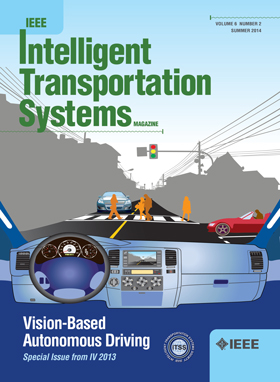Vision-Based Geometric Model for Accurate and Fast Lane Recognition in Complex Conditions
IF 7.9
1区 工程技术
Q1 ENGINEERING, CIVIL
IEEE Transactions on Intelligent Transportation Systems
Pub Date : 2025-02-27
DOI:10.1109/TITS.2025.3543809
引用次数: 0
Abstract
Lane recognition is an important component of autonomous driving system and advanced driving assistance system (ADAS) for intelligent vehicles. In complex driving conditions, accurate and fast lane recognition is a challenging issue. In this paper, a vision-based geometric model (VBGM) is proposed for accurate and fast lane recognition in complex conditions. The framework of the VBGM includes an image preprocessing stage and a lane recognition stage. In the image preprocessing stage, the region of interest (ROI) is extracted from the original image, and the original image is transformed into an undistorted greyscale image. In the lane recognition stage, the lane contour is first extracted using the Roberts operator. Then, to accurately and quickly recognize the lane marking, a lane recognition coordinate system (LRCS) and a rotational LRCS (R-LRCS) are constructed. The distracting contours in abnormal regions are padded based on the LRCS using a contextual frames correlation (CFC) strategy, and the midpoints of the lane contour are identified based on the R-LRCS. Finally, an adaptive-order polynomial fitting model is built to fit the lane marking according to the midpoints in the LRCS. To evaluate the effectiveness of the proposed method, two state-of-the-art methods are selected for comparison. The comparative results indicate that the proposed method possesses a higher recognition rate and speed for lane recognition in complex conditions.基于视觉的复杂车道快速准确识别几何模型
车道识别是自动驾驶系统和智能汽车高级驾驶辅助系统(ADAS)的重要组成部分。在复杂的驾驶条件下,准确快速的车道识别是一个具有挑战性的问题。本文提出了一种基于视觉的车道快速准确识别方法(VBGM)。VBGM的框架包括图像预处理阶段和车道识别阶段。在图像预处理阶段,从原始图像中提取感兴趣区域(ROI),并将原始图像转换为未失真的灰度图像。在车道识别阶段,首先使用罗伯茨算子提取车道轮廓;然后,为了准确、快速地识别车道标记,分别构建了车道识别坐标系(LRCS)和旋转LRCS (R-LRCS)。在LRCS的基础上,采用上下文框架关联(CFC)策略填充异常区域的分心轮廓,并基于R-LRCS识别车道轮廓的中点。最后,根据LRCS中的中点,建立自适应阶多项式拟合模型对车道标线进行拟合。为了评估所提出的方法的有效性,选择了两种最先进的方法进行比较。对比结果表明,该方法对复杂条件下的车道识别具有较高的识别率和速度。
本文章由计算机程序翻译,如有差异,请以英文原文为准。
求助全文
约1分钟内获得全文
求助全文
来源期刊

IEEE Transactions on Intelligent Transportation Systems
工程技术-工程:电子与电气
CiteScore
14.80
自引率
12.90%
发文量
1872
审稿时长
7.5 months
期刊介绍:
The theoretical, experimental and operational aspects of electrical and electronics engineering and information technologies as applied to Intelligent Transportation Systems (ITS). Intelligent Transportation Systems are defined as those systems utilizing synergistic technologies and systems engineering concepts to develop and improve transportation systems of all kinds. The scope of this interdisciplinary activity includes the promotion, consolidation and coordination of ITS technical activities among IEEE entities, and providing a focus for cooperative activities, both internally and externally.
 求助内容:
求助内容: 应助结果提醒方式:
应助结果提醒方式:


